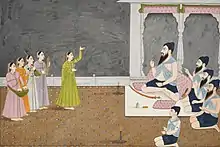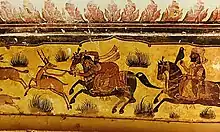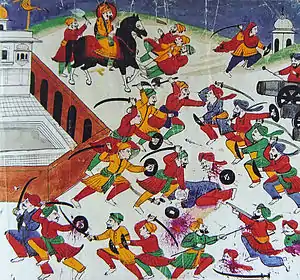| Part of a series on |
| Women in society |
|---|
.svg.png.webp) |
| Part of a series on |
| Sikhism |
|---|
 |
The principles of Sikhism state that women have the same souls as men and thus possess an equal right to cultivate their spirituality[1] with equal chances of achieving salvation.[2] Women in Sikhism participate in all religious, cultural, social, and secular activities including lead religious congregations, take part in the Akhand Path (the continuous recitation of the Holy Scriptures), perform Kirtan (congregational singing of hymns), perform Gatka (Sikh martial art) and work as a Granthis.[1]
Guru Nanak proclaimed the equality of men and women, and both he and the gurus that succeeded him encouraged men and women to take a full part in all the activities of Sikh worship and practice.[3] Sikh history also has recorded the role of women, portraying them as equals to men in service, devotion, sacrifice, and bravery.[4]
History
_but_his_horse_kicked_and_the_Guru_wrote_the_numeral_seven_(%E0%A9%AD)_instead.jpg.webp)
The Sikh Gurus and various Sikh saints did much to progress women's rights which were considerably downtrodden in the 15th century. To ensure a new equal status for women,[5] the Gurus[6] made no distinction between the sexes in matters of initiation, instruction or participation in sangat (holy fellowship) and pangat (eating together).
Guru Amar Das
According to Sarup Das Bhalla, Mahima Prakash, Guru Amar Das disfavoured the use of the veil by women. He assigned women to supervise some communities of disciples and preached against the custom of sati. Guru Amar Das also raised his voice against female infanticide.[7] Guru Amar Das had appointed a Sikh woman, named Mai Matho, as head of one of the Manji diocese in-contrast to the prevailing patriarchal hierarchy of his era.[8]
Guru Gobind Singh
Guru Gobind Singh instructed the Khalsa to not associate with kanyapapi, those who sin towards woman, and the Guru was also strongly against the objectification of woman.[9] The Guru gave those women who were baptized into the Khalsa, the surname of Kaur, the status of a sovereign princess.[10][11]
Ram Singh Namdhari
Baba Ram Singh also did much for woman's rights including opposing infanticide, selling of young girls into servitude, the dowry system, the pardah system,[12] and endeavored to achieve higher standards of literacy, and the remarriage of widows.[13][14]
Singh Sabha
During the Sikh revival movement of Singh Sabha beginning in the 1870s, the Singh Sabha raised its voice against the purdah system, female infanticide, child marriage, sati, bad conditions of widows, practice of dowry and extravagant expenditure during marriage.[7]
Practices condemned

Sutak
Sutak is a belief associated with impurity of the house on account of birth of a child. It is also believed that women are most prone to such impurity. Guru Nanak condemned such notions of pollution/impurity in no uncertain terms.[15][16]
Should Sutak be believed in, then that such impurity occurs everywhere, Worms are found in cow dung and the wood. No single grain of corn is without life in it. Water is the first source of life, and everyone is dependent on it for remaining alive. How can impurity of Sutak be warded off? It is to be found in every kitchen. Nanak says, pollution is not removed in this way (through rituals). It is washed away by knowledge of God (enlightenment).
— Guru Nanak, Guru Granth Sahib 472 [15]
Asceticism
The concept of Sannyasa had influenced attitude towards women in India. The inherent attraction of female was considered a temptation something that a Sannyasi must avoid. The Gurus, however, did not regard women as hurdles for attaining salvation. They rejected the idea of renunciation and regarded family life, if led in a righteous manner, better than the life of an ascetic.[17] Instead of celibacy and renunciation, Guru Nanak recommends grihastha—the life of a householder.[18]
Menstrual taboo
Menstruation does not lead to women being considered impure in Sikhism, and women's behavior is not restricted during the time when she is menstruating.[19]
In The Feminine Principle in the Sikh vision of the transcendent, Nikky-Guninder Kaur Singh writes:
- 'The denigration of the female body "expressed in many cultural and religious taboos surrounding menstruation and child-Birth" is absent in the Sikh worldview. Guru Nanak openly chides those who attribute pollution to women because of menstruation'.[20]
Polygamy

In a culture where monogamy is generally the rule, Sikh polygamy is exceptionally rare.[21]
Female infanticide
Female infanticide is prohibited, and the Rahitnamas (codes of conduct) prohibit Sikhs from having any contact or relationship with those who indulge in this practice.[22][23]
Sati (widow burning)

Widow burning, or sati, is expressly forbidden by scripture.
Satis are not those that burn themselves on the husband's funeral pyre; satis are they, O Nanak, who die of the pangs of separation (from the supreme God)
— Guru Amar Das, Guru Granth Sahib 787 [24]
As a practical step towards discouraging the practice of sati Sikhism permits remarriage of widows.[24]
Veil
Sikhism was highly critical of all forms of strict veiling, Sikh Gurus condemned it and rejected seclusion and veiling of women, which saw decline of veiling among some classes during late medieval period.[25] This was stressed by Bhagat Kabir.[26]
Stay, stay, O daughter-in-law - do not cover your face with a veil. In the end, this shall not bring you even half a shell. The one before you used to veil her face; do not follow in her footsteps. The only merit in veiling your face is that for a few days, people will say, "What a noble bride has come". Your veil shall be true only if you skip, dance and sing the Glorious Praises of the Lord. Says Kabeer, the soul-bride shall win, only if she passes her life singing the Lord's Praises.
— Bhagat Kabir, Guru Granth Sahib 484 [26]
Dowry
Guru Ram Das condemned the ritual of dowry.[27]
Any other dowry, which the self-willed manmukhs offer for show, is only false egotism and a worthless display. O my father, please give me the Name of the Lord God as my wedding gift and dowry.
— Guru Ram Das, Guru Granth Sahib 79 [27]
Equality

According to Sikhism, men and women are two sides of the same human coin. There is a system of interrelationship and interdependence whereby man is born of women, and women are born of man's seed. By these doctrines a man cannot feel secure and complete in his life without a woman, and man's success is proportional to the love and support of the woman who shares her life with him (and vice versa).[28] The founder of Sikhism, Guru Nanak, reportedly said in 1499 that "[it] is a woman who keeps the race going" and that we should not "consider woman cursed and condemned, [when] from woman are born leaders and kings."[28]
Status of women
Historical


There are many examples of women who are considered models of service and sacrifice throughout Sikh history, such as Mata Gujri, Mai Bhago, Mata Sundari, Mata Desan Kaur, Rani Sahib Kaur, Rani Sada Kaur, Rani Datar Kaur and Maharani Jind Kaur.[29]
Current
In the present-day democratic politics of India, a fair amount of organizations study and work in order to rid women of many of their disadvantages. They have access to political franchise and new opportunities for advancement have opened up for them. Sikh women have shown enterprise in several fields and are among the most progressive in education and in the professions such as teaching and medicine. Within the Sikh system, they are the equals of men. They can lead congregational services and participate in akhand paths, uninterrupted readings of scripture to be accomplished within seventy-two hours. They vote with men to elect Sikhs' central religious body, the Shiromani Gurdwara Parbandhak Committee, which administers their places of worship (Gurdwara).
%252C_1906.jpg.webp)
Sikhs are obligated to treat women as equals, and gender discrimination in Sikh society has no religious basis. However, gender equality has been difficult to achieve in practice due to heavy social, cultural, and caste-related pressure. It's worth noting that the caste system itself goes against the core principles of Sikhism.
Though equality for women has always been a major attribute of Sikhism and a great number of women have made significant contributions, it is important to note that it is still a work in progress. In the 1990s a group of Sikh women requested to wash the floors or the Darbar Sahib and were denied. Unlike men, women are still not allowed to assist in carrying the paliquin carrying the primary scriptures in its path to and from the Golden Temple. Also, women make up less than 20% of the SGPC members.
While diaspora women take lead in opening many aspects of ritual life for women still female participation in various religious rituals and institutions is very uncommon. Ritual services like ‘chaur seva’ wherein one uses an implement called the chaur to fan the Granth, or Sukh-aasan ritual at Harmandir Sahib ritual where the Guru Granth Sahib is shifted from the sanctum sanctorum to the Akal Takht precincts or Kirtan at golden temple, are mostly male-dominated. So also profession of Granthis to Gurudwara management are mostly male dominated fields. Part of the problem while religion officially does not hold menstruating women to be impure still patriarchy in Sikh society holds the same as taboo.[30]
Kaur Project
Kaur Project is a project that seeks to actively create spaces for Sikh female youth to learn and lead the Hukumnama, Ardaas, Sahajpaath, Akandpaath and Parshaad seva.[30]
Notable women in Sikhism
- Mata Gujri Kaur Ji, wife of Guru Tegh Bahadur Ji and mother of Guru Gobind Singh Ji
- Mata Kaulan, disciple of Guru Hargobind
- Mata Sahib Kaur, wife of Guru Gobind Singh and leader of the Khalsa for 40 years
- Mata Susheel Kaur, wife of Banda Singh Bahadur who fought alongside him
- Sada Kaur, chief of the Kanhaiya Misl from 1789 to 1821
- Maharani Datar Kaur, consort of Maharaja Ranjit Singh and mother of Maharaja Kharak Singh she served as a commander during the Battle of Multan (1818)
- Maharani Chand Kaur, ruler of Sikh Empire
- Rani Jindan, wife of Ranjit Singh
- Princess Sophia Duleep Singh, prominent suffragette of womans civil rights movemenent in the United Kingdom
- Mata Khivi, notable for her contributions to the establishment of Langar[31]
- Mata Tripta, mother of Guru Nanak
- Bebe Nanaki, elder sister of Guru Nanak[32]
- Mai Bhago, prominent Sikh warrior
See also
- Women in the Guru Granth Sahib
- Sikh feminism
- Women in India
- Women's rights
- Legal rights of women in history
- Kaur, the name bestowed upon Sikh girls and women by Guru Gobind Singh in 1699
References
- 1 2 "Sikhism: What is the role and status of women in Sikh society?". www.realsikhism.com. Archived from the original on 2015-08-06. Retrieved 2015-11-07.
- ↑ Howard, Veena (2017). Dharma: The Hindu, Jain, Buddhist and Sikh Traditions of India. I.B.Tauris. ISBN 9781786722126.
- ↑ Holm, Jean; Bowker, John (1994). Women in Religion. Continuum International Publishing. ISBN 9780826453044. Retrieved 18 March 2013.
- ↑ Kaura, Bhupindara (2000). Status of women in Sikhism. Shiromani Gurdwara Parbandhak Committee. p. 56.
- ↑ Singh, Jagraj (2009). A Complete Guide to Sikhism. Unistar Books. p. 285. ISBN 9788171427543.
- ↑ "Sikhism Religion of the Sikh People".
- 1 2 Gill, Manmohan (2003). Punjab Society: Perspectives and Challenges. Concept Publishing Company. p. 44. ISBN 9788180690389.
- ↑ Jain, Harish C. (2003). The Making of Punjab. Unistar Books. p. 273.
- ↑ Singh, Nikky-Guninder (2012). Birth of the Khalsa, The: A Feminist Re-Memory of Sikh Identity. SUNY Press. p. 57. ISBN 9780791482667.
- ↑ Wilcockson, Michael (2015). 9.4 The Khalsa Religious Studies for Common Entrance 13+ Revision Guide. London: Hodder Education. ISBN 9781471850905.
- ↑ "FAQ". Sikh Coalition. Retrieved 2020-05-02.
- ↑ "The Panjab Past and Present". Vol. 7. Department of Punjab Historical Studies, Punjabi University. 1973. p. 149.
- ↑ Clarke, Peter (2004). Encyclopedia of New Religious Movements. Oxon: Routledge. p. 425. ISBN 9781134499700.
- ↑ Grewal, Gurdial (1991). Freedom Struggle of India by Sikhs and Sikhs in India: The Facts World Must Know, Volume 1. Sant Isher Singh Rarewala Education Trust. p. 146.
- 1 2 Singh, Jagraj (2009). A Complete Guide to Sikhism. Unistar Books. pp. 116–117. ISBN 978-8-1714-2754-3.
- ↑ Rait, S.K. (2005). Sikh Women in England: Their Religious and Cultural Beliefs and Social Practices. Trentham Books. p. 72. ISBN 9781858563534.
- ↑ Rait, S.K. (2005). Sikh Women in England: Their Religious and Cultural Beliefs and Social Practices. Trentham Books. p. 49. ISBN 9781858563534.
- ↑ Kapoor, Sukhbir (1999). Guru Granth Sahib: An Introductory Study. Hemkunt Press. p. 148.
- ↑ Shahi, Mukesh Kumar (2018). Period & Emotion: Educate Yourself and your Family. Evincepub Publishing. p. 13. ISBN 9789388277655.
- ↑ Kaur-Singh, Nikky-Guninder (1993). The Feminine Principle in the Sikh Vision of the Transcendent. Cambridge University Press ISBN 0521432871. pp. 4.
- ↑ Rait, S. K. (2005). polygamy rare Sikh Women in England: Their Religious and Cultural Beliefs and Social Practices. Staffordshire: Trentham. p. 52. ISBN 9781858563534.
- ↑ Gandhi, Surjit (1978). History of the Sikh Gurus. Gur Das Kapur. p. 505.
- ↑ Harbans, Bhatia; Bakshi, Shiri Ram (1999). Political Ideology Of The Sikhs. Deep & Deep Publications. p. 33. ISBN 9788176291354.
- 1 2 Singh, Darshan (January 2004). Guru Granth Sahib Among The Scriptures Of The World. Patiala: Punjabi University. p. 196. ISBN 9788173809286.
- ↑ Singh, Sardar Harjeet (2009). The Position of Women in Hindu Civilization. p. 259.
- 1 2 Jhutti-Johal, Jagbir (2011). Sikhism Today. A&C Black. p. 35. ISBN 9781847062727.
- 1 2 Pruthi, Raj (2004). Sikhism and Indian Civilization. Discovery Publishing House. p. 105. ISBN 9788171418794.
- 1 2 Aad Guru Granth Sahib. Amritsar: Shiromani Gurdwara Parbandhak Committee. 1983.
- ↑ "Great Sikh Women – Great Sikh Women". Gateway to Sikhism Foundation. Retrieved 2018-09-24.
- 1 2 Desai, Ketaki (14 April 2020). "How Sikh women in diaspora communities are fighting for their rights". The Times of India. TNN. Retrieved 2020-12-09.
- ↑ Cantlon, Marie; Ruether, Rosemary; Keller, Rosemary (2006). Encyclopedia of Women and Religion in North America: Native American creation stories. Indiana: Indiana University Press. p. 695. ISBN 9780253346872.
- ↑ History
- Guru Granth Sahib, p 73.
- Guru Granth Sahib, p 788.
